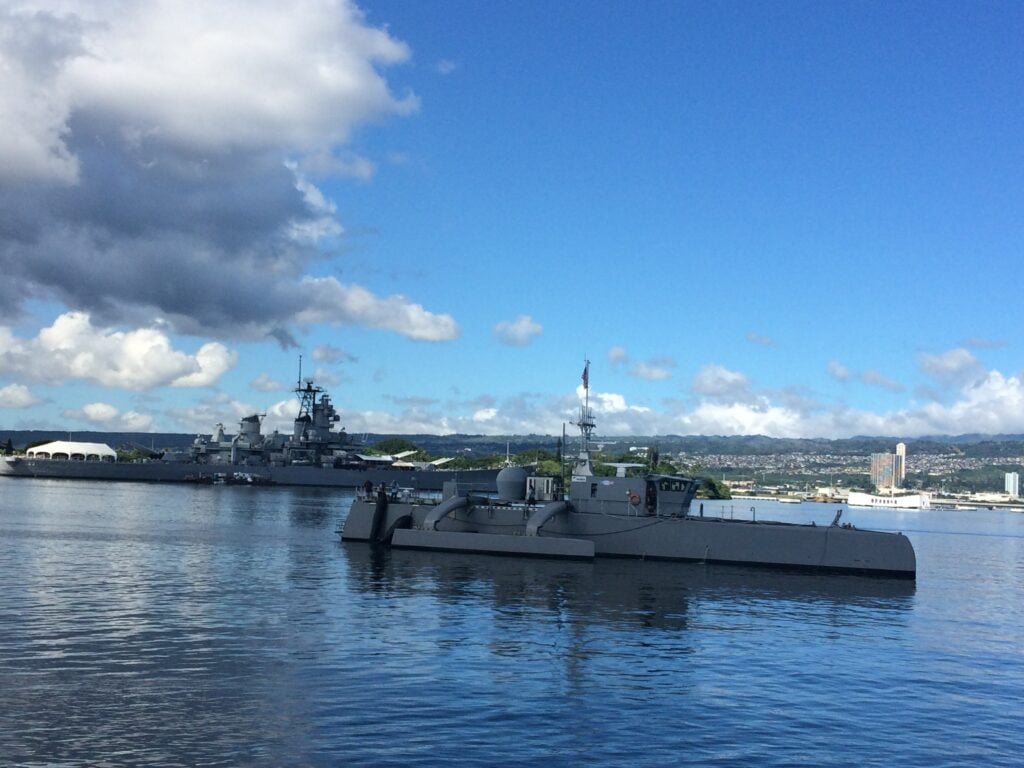
Sea Hunter, an unmanned surface vehicle developed by Office of Naval Research and DARPA
WASHINGTON: The Navy needs to comb through a host of thorny issues before deploying a new fleet of unmanned ships to confront China, Russia, and Iran.
“You don’t hear me talking about artificial intelligence and machine learning and things like that just yet,” said Capt. Pete Small, the Navy’s program manager for Unmanned Maritime Systems at a C4ISRnet conference this morning. “Those aren’t my first concerns. My first concerns are about the field stability and sustainability of these systems right now.”
The Navy just isn’t equipped to deploy or sustain a new fleet of unmanned vessels yet. “Our infrastructure right now is optimized around manned warships,” Small said. “We’re gonna have to shift that infrastructure for how we prepare, deploy, and transit” over large bodies of water before large numbers of unmanned vessels can be effective, he said.
It’s not clear where that planning stands, but the service has already invested tens of millions in the early work of developing a family of large and medium unmanned vessels, and is looking to vastly ramp that up in the 2021 budget, asking for $580 million for research and development.
In 2019 an unmanned Sea Hunter prototype autonomous vessel sailed from San Diego to Hawaii, but it needed to repair several broken systems along the way, forcing sailors to board the ship. It was the first experiment of its kind, one the Navy has not repeated. Those mechanical problems point to work the Navy must do to reconfigure its logistics tail to meet the needs of a new class of ship.
“We’re going to have to transition from a [system] more optimized around our manned fleet infrastructure to a more distributed mix of these large manned platforms to smaller platforms,” Small said, “we’re gonna need to talk about things like, tenders for heavy lift ships, or forward operating bases, things like that.”
The early thinking is the service will use the ships as sensors deployed well forward of manned ships and carrier strike groups, which could be at risk if they maneuvered too close to contested waters. But the Navy isn’t going to pin everything on a nascent fleet of robot boats — a new class of manned frigates is also being built to operate inside the range of enemy precision weapons. The frigates are going to be smaller and faster than current destroyers, with the ability to generate much more power so they can use lasers and other weapons for both offensive and defensive missions.
The Navy is considering several sizes of USVs, including a large variant between 200 and 300 feet in length and having full load displacements of 1,000 tons to 2,000 tons. The ships should be low-cost, and reconfigurable with lots of room capacity for carrying various payloads, including mine hunting and anti-surface warfare.
The 2021 budget submission proposes using research and development funding to acquire two more prototypes and another in 2022. Plans then call for buying deployable LUSVs at a rate of two per year.
Medium unmanned ships will likely come in at between 45 to 190 feet long, with displacements of roughly 500 tons. The medium ships are thought to skew more toward mission modules revolving around intelligence, surveillance and reconnaissance payloads and electronic warfare systems. The first MUSV prototype was funded in 2019, and the Navy wants to fund a second prototype in 2023.
Fundamental issues need to be sorted out before the Navy buys one of these ships.
“We need to find a balance of vehicle designs that enables the cost to be cheap enough that we can afford them, but it’s not so highly optimized towards the purely unmanned spectrum that it’s cost prohibitive to maintain them,” Small said. If the maintenance is too complicated and time consuming, and “we have to take the whole vehicle out of the water and take it apart in some explicit manner to replace the parts, it’s not gonna really support what we need in the field. So really, the sustainability of the technology is as important — if not more important — in the near-term than the technology itself.”
Iran says it shot down Israel’s attack. Here’s what air defense systems it might have used.
Tehran has been increasingly public about its air defense capabilities, including showing off models of systems at a recent international defense expo.


























